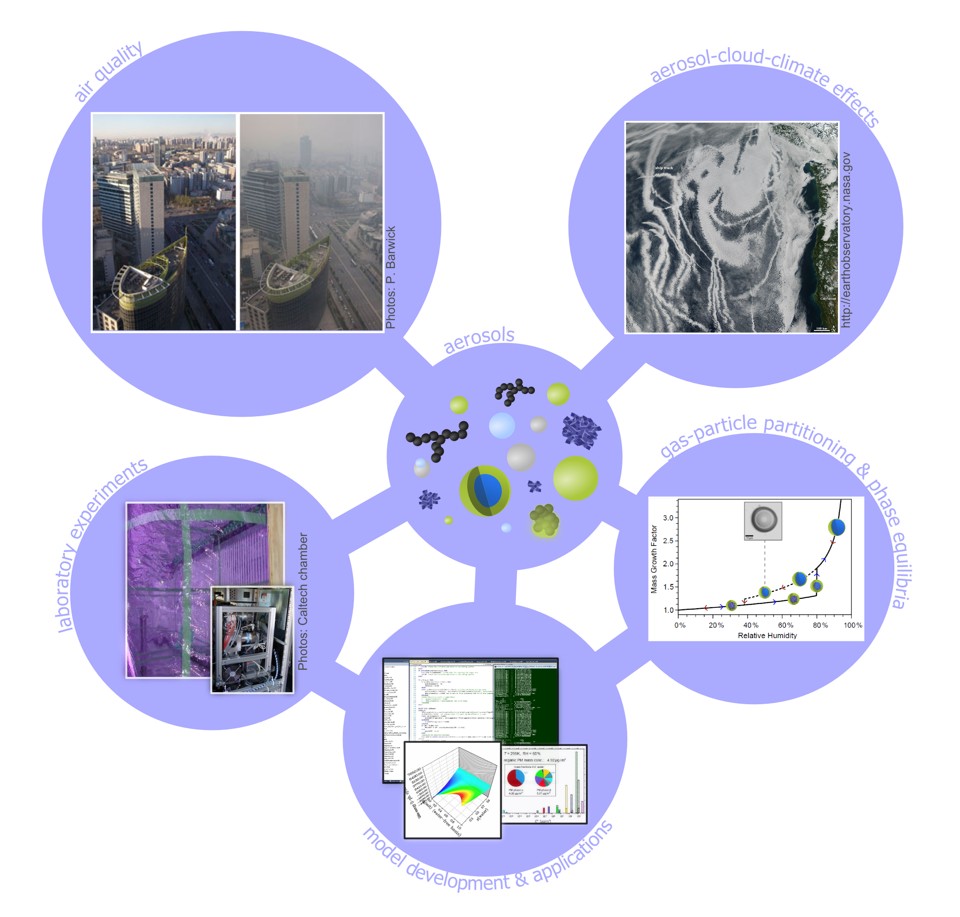★ Welcome ★
Explore the website of Prof. Andreas Zuend's "Aerosols, Clouds and Climate" research group. We are a group within the Department of Atmospheric and Oceanic Sciences at McGill University.
Atmospheric Aerosols – tiny, but important indeed ↑Top
Fig. H1. A schematic view of relevant interactions between aerosol particles, the environment, and approaches to study them in the laboratory and with numerical models.[Source: figure by A. Zuend]
Atmospheric aerosols – tiny particles suspended in the air – are of fundamental importance for urban and regional air quality, clouds and the global climate system. Aerosols are among the least understood and quantified climate agents, affecting Earth’s radiation balance directly as well as indirectly via their crucial role in the formation of cloud droplets and influence on cloud microphysics. Part of the lack of knowledge is due to the complexity and variety of primary and secondary particle sources, the chemical composition, phases, and physical states of aerosols and the evolution of these properties by means of chemical and physical processing in the air.
Our research projects are motivated by the need to understand, on a quantitative level, the chemical thermodynamics, reactions, and mass transfer kinetics of complex mixtures consisting of tens to thousands of oxidized organic compounds, water, and inorganic salts and acids that form and characterize the majority of secondary aerosols in the troposphere. Learn more about current activities on the Research page.
News and Events ↑Top
June 12, 2025: Camilo's paper titled "Implications of reduced-complexity aerosol thermodynamics on organic aerosol mass concentration and composition over North America", has been published in final form in ACP (see reference here). Congratulations, Camilo, for leading this work! In this paper, we implemented the BAT-VBS (Binary Activity Thermodynamics volatility basis set) aerosol thermodynamics model in the GEOS-Chem chemical transport model to efficiently account for organic aerosol water uptake, nonideal mixing, and impacts on the gas–particle partitioning of semi-volatile organics. Compared to GEOS-Chem's complex (dry) scheme, we show that the BAT-VBS model can predict substantial enhancements in organic aerosol mass concentration at moderate-to-high relative humidity.
January 9, 2025: Ryan's paper titled "The role of interfacial tension in the size-dependent phase separation of atmospheric aerosol particles", has been published in final form (see reference here). Congratulations, Ryan! This paper extends the AIOMFAC-based modeling framework for size-dependent aerosol processes of Schmedding and Zuend (2023), such as bulk–surface partitioning and activation of aerosols into cloud droplets, by considering the impact of liquid–liquid interfaces within phase-separated droplets.
January 7, 2022: Ampritta's modeling paper on the water uptake effects on isoprene-derived SOA, a product of a collaboration with many researchers from CERN's CLOUD project and the Paul Scherrer Institute in Switzerland, has been published in final form (see reference here). Congratulations, Ampritta, and thanks to all co-authors and contributors.
September 27, 2021: We welcome our newest group members, MSc students Zixuan and Dan, and undergraduate researcher Michel.
And, we say goodbye to Hang Yin and Mees Franssen. Mees has been a summer student in 2021, working on a machine learning approach for our work on organic surface tension.
August 31, 2021: Congratulations to MSc students Hang Yin and Joe Lilek for successfully completing their thesis research and MSc degrees!
Hang's thesis project has extended the AIOMFAC model by a number of new ionic species (iodide, iodate, carbonate, bicarbonate, OH-) as well as aqueous CO2 and the interactions of these species with other ions and organic functional groups (see reference here).
Joe's thesis research was focused on viscosity model development, with major additions to the AIOMFAC-VISC model, including an accurate treatment of aqueous electrolyte solutions and coupled organic–inorganic mixtures (see also references here).
March, 12, 2020: Two of our recent scientific articles are now available in final publication form in the journal Atmospheric Chemistry and Physics (ACP). Congratulations, Kyle and Natalie, for your key roles and initiative in developing these projects.
(1) Our paper on the reduced-complexity model 'BAT' and RH-dependent organic aerosol water uptake and gas–particle partitionig, first-authored by Kyle Gorkowski, has been published in ACP already back in November (see reference here).
(2) Our paper introducing AIOMFAC-VISC titled "A predictive group-contribution model for the viscosity of aqueous organic aerosol", first-authored by Natalie Gervasi, was published today (see reference here). August 13, 2018: Interested in aerosol and/or liquid phase thermodynamic models? Version 2.20 of the source code of the AIOMFAC group-contribution activity coefficient model (written in modern Fortran) is now made availabe publicly via the https://github.com/andizuend/AIOMFAC online repository. The GitHub repository includes the core source code of AIOMFAC, including a simple driver program, which is also running the AIOMFAC-web online calculations. August 13, 2018: New server at McGill University for the AIOMFAC website. We have installed a new, powerful server for hosting the AIOMFAC-web model via the following URL: https://aiomfac.lab.mcgill.ca. The previous, temporary server at McGill (mentioned below) will now redirect to this address. In future, the new server will allow us to provide additional online computation features. November 23, 2017: Looking for the AIOMFAC website? The AIOMFAC model website hosted at Caltech, http://www.aiomfac.caltech.edu, has suffered some downtime during the past days due to necessary server hardware repairs. To avoid longer unavailabilities in future, the AIOMFAC model website is now also hosted on a server at McGill University, currently accessible via the following URL: https://web.meteo.mcgill.ca/aiomfac/ [edit: see message above regarding the new AIOMFAC web server]. June 21, 2017: Our research collaboration work titled Surface tension prevails over solute effect in organic-influenced cloud droplet activation has just been published by Nature online - doi:10.1038/nature22806. See also the brief overview here. January 13, 2017: Open position for a Postdoctoral researcher in atmospheric aerosol modeling. [Edit: this position has been filled] August 30, 2013: This group website is launched in its inital version.
More Information ↑Top
Interested in our research? Looking for research opportunities? Would you like more detailed information? Feel free to contact us.
|

